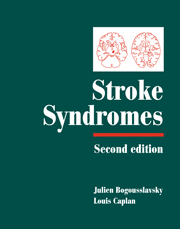Book contents
- Frontmatter
- Contents
- List of contributors
- Preface
- PART I CLINICAL MANIFESTATIONS
- 1 Stroke onset and courses
- 2 Clinical types of transient ischemic attacks
- 3 Hemiparesis and other types of motor weakness
- 4 Sensory abnormality
- 5 Cerebellar ataxia
- 6 Headache: stroke symptoms and signs
- 7 Eye movement abnormalities
- 8 Cerebral visual dysfunction
- 9 Visual symptoms (eye)
- 10 Vestibular syndromes and vertigo
- 11 Auditory disorders in stroke
- 12 Abnormal movements
- 13 Seizures and stroke
- 14 Disturbances of consciousness and sleep–wake functions
- 15 Aphasia and stroke
- 16 Agitation and delirium
- 17 Frontal lobe stroke syndromes
- 18 Memory loss
- 19 Neurobehavioural aspects of deep hemisphere stroke
- 20 Right hemisphere syndromes
- 21 Poststroke dementia
- 22 Disorders of mood behaviour
- 23 Agnosias, apraxias and callosal disconnection syndromes
- 24 Muscle, peripheral nerve and autonomic changes
- 25 Dysarthria
- 26 Dysphagia and aspiration syndromes
- 27 Respiratory dysfunction
- 28 Clinical aspects and correlates of stroke recovery
- PART II VASCULAR TOPOGRAPHIC SYNDROMES
- Index
- Plate section
16 - Agitation and delirium
from PART I - CLINICAL MANIFESTATIONS
Published online by Cambridge University Press: 17 May 2010
- Frontmatter
- Contents
- List of contributors
- Preface
- PART I CLINICAL MANIFESTATIONS
- 1 Stroke onset and courses
- 2 Clinical types of transient ischemic attacks
- 3 Hemiparesis and other types of motor weakness
- 4 Sensory abnormality
- 5 Cerebellar ataxia
- 6 Headache: stroke symptoms and signs
- 7 Eye movement abnormalities
- 8 Cerebral visual dysfunction
- 9 Visual symptoms (eye)
- 10 Vestibular syndromes and vertigo
- 11 Auditory disorders in stroke
- 12 Abnormal movements
- 13 Seizures and stroke
- 14 Disturbances of consciousness and sleep–wake functions
- 15 Aphasia and stroke
- 16 Agitation and delirium
- 17 Frontal lobe stroke syndromes
- 18 Memory loss
- 19 Neurobehavioural aspects of deep hemisphere stroke
- 20 Right hemisphere syndromes
- 21 Poststroke dementia
- 22 Disorders of mood behaviour
- 23 Agnosias, apraxias and callosal disconnection syndromes
- 24 Muscle, peripheral nerve and autonomic changes
- 25 Dysarthria
- 26 Dysphagia and aspiration syndromes
- 27 Respiratory dysfunction
- 28 Clinical aspects and correlates of stroke recovery
- PART II VASCULAR TOPOGRAPHIC SYNDROMES
- Index
- Plate section
Summary
Introduction, definition of terms, and frequency of the problem
The fundamental feature of delirium is disordered attention. Delirious patients cannot focus and sustain attention on one stimulus among multiple stimuli, and cannot shift attention at will. Table 16.1 lists diagnostic criteria for delirium from the American Psychiatric Association. If delirious patients are attentive enough to allow testing, abnormalities of thinking, perception, and memory will usually be found. The abnormalities may include disorientation to time and place, impaired immediate, recent, and remote memory, dysnomia, agraphia, and visual-spatial dysfunction. Much of the difficulty with perceptual function and speech output relates to the inability to sustain attention to the task at hand. Illusions, hallucinations, and delusions may also be prominent. Sleep–wake patterns are usually abnormal with reduced wakefulness during the day and reduced, often fragmented sleep at night. Autonomic hyperactivity produces flushing, mydriasis, sweating, tachycardia, and labile blood pressures. Delirious patients may quickly shift from hyperactivity to reduced activity. During the day lethargy and even catatonic behaviour may predominate, shifting at night to agitation, shouting, and aggressive behaviour.
The terms delirium, confused, agitation, and confusional state are used variously by different neurologists and psychiatrists. The criteria cited in Table 16.1 incorporate several very different elements including acuteness of onset, altered thought and concentration, level of consciousness, and cause. Confusion is defined by Adams et al. (1997) as:
denoting the patient's incapacity to think with customary speed, clarity, and coherence.
- Type
- Chapter
- Information
- Stroke Syndromes , pp. 222 - 231Publisher: Cambridge University PressPrint publication year: 2001
- 1
- Cited by



